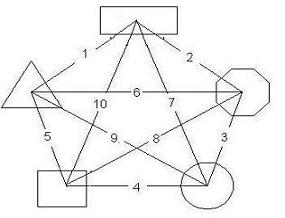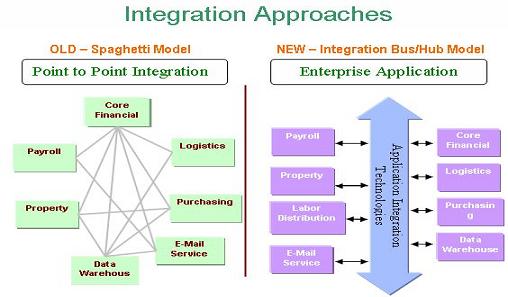
- SAP Community
- Products and Technology
- Additional Blogs by Members
- EAI Primer for XI and Middleware Technologies
Additional Blogs by Members
Turn on suggestions
Auto-suggest helps you quickly narrow down your search results by suggesting possible matches as you type.
Showing results for
Former Member
Options
- Subscribe to RSS Feed
- Mark as New
- Mark as Read
- Bookmark
- Subscribe
- Printer Friendly Page
- Report Inappropriate Content
01-22-2007
6:34 AM
Hello everyone!
First, a little about me. I began working on SAP ABAP, but groping with XI and learning the tricks of this trade now. This is my first blog posted in SDN. This blog will give an over all idea about Enterprise Application Integration (EAI), which can be useful for anyone starting on XI (or any other middleware Technologies)
Enterprise Application Integration:
In earlier days companies bought software solutions like SAP, PeopleSoft, Oracle ERP, IDEdwards, Siebel etc. and those software solutions would work very well individually, but create silos of information. In many cases each individual system produced excessive information. When common information changed, we updated the information in each system manually and the process became difficult to handle. Ultimately some of the data across the system became inconsistent. When people noticed those resulting inconsistence in data and double entry data, they decided to get ways to integrate the systems. From that EAI (Enterprise Application Integration) was developed.
EAI allows the flow of information across the different systems. By connecting the different processes ,softwares and hardwares of more enterprises to become one enterprise system. The main motto of the Enterprise Application Integration is to condense the efforts needed for designing and coding. And it allows reuse of configurations or codes for the new system. It reduces the maintenance costs and difficulties of the custemers.
The main objective of the EAI : Automation of different Business Processes Streamlines information flows across various enterprise systems Ease of maintenance in the enterprises Provides efficient, flexible and scalable Architecture Provides reusable (adapters, models etc..) and secured frameworks Reduces maintenance costs for interfaces.
In EAI there are two logical integration architectures. Direct point-to-point connects and middleware based integration.
Point-to-point integration
EAI developer follow point-to-point integration because they found it easy to understand and it can implement quickly for few systems to integrate. One example of point-to-point integration is one application makes direct database connection calls to another application’s database tables. Initially when we integrate two application systems the point-to-point integration is right choice. When we integrate additional applications we get a situation shown in below figure.
 HCL Technologies
HCL Technologies
Later stages of a point-to-point integration
In this each application is tightly coupled with the other applications through point-to-point connection. If we change one application it may break the other integrated applications. If we have five applications to be integrated with each other we will need ten different integration points showed in below figure.And each additional application becomes difficult to integrate and maintain.
 HCL Technologies
HCL Technologies
More point-to-point connections
To avoid those problems we required an intermediate layer to isolate the changes in one application from the other applications.
Middleware-based integration
Middleware provides interfaces with all integrated applications passing messages to each other and each interface defines a business process provided by the application. The below figure shows the service-oriented architecture using middleware.
 HCL Technologies
HCL Technologies
Middleware-based integration
Service-oriented architecture adds and replace applications without affecting the other applications. If we have ten applications to integrate we will have just ten integration points. It supports a larger number of integrated applications and less maintenance. Middleware can perform complex operations from application to applications.
The additional complexity is setting up the middleware and converting the existing application to use the middleware API.
 HCL Technologies
HCL Technologies
Major EAI Solution Providers:
SAP WebMethods TIBCO IBM Vitria SeeBeyond Microsoft EAI can integrate Legacy / Mainframe, Client-Server, Web, e-Commerce, ERP / CRM / HRMS, Custom applications, etc. Various functionalities of EAI are Messaging ,Interfacing, Transformation, Routing and Process Modeling.
 HCL Technologies
HCL Technologies
I hope this sneak peak into EAI was interesting to some of you. If you find any errors or have other input don't hesitate to comment here.
First, a little about me. I began working on SAP ABAP, but groping with XI and learning the tricks of this trade now. This is my first blog posted in SDN. This blog will give an over all idea about Enterprise Application Integration (EAI), which can be useful for anyone starting on XI (or any other middleware Technologies)
Enterprise Application Integration:
In earlier days companies bought software solutions like SAP, PeopleSoft, Oracle ERP, IDEdwards, Siebel etc. and those software solutions would work very well individually, but create silos of information. In many cases each individual system produced excessive information. When common information changed, we updated the information in each system manually and the process became difficult to handle. Ultimately some of the data across the system became inconsistent. When people noticed those resulting inconsistence in data and double entry data, they decided to get ways to integrate the systems. From that EAI (Enterprise Application Integration) was developed.
EAI allows the flow of information across the different systems. By connecting the different processes ,softwares and hardwares of more enterprises to become one enterprise system. The main motto of the Enterprise Application Integration is to condense the efforts needed for designing and coding. And it allows reuse of configurations or codes for the new system. It reduces the maintenance costs and difficulties of the custemers.
The main objective of the EAI :
In EAI there are two logical integration architectures. Direct point-to-point connects and middleware based integration.
Point-to-point integration
EAI developer follow point-to-point integration because they found it easy to understand and it can implement quickly for few systems to integrate. One example of point-to-point integration is one application makes direct database connection calls to another application’s database tables. Initially when we integrate two application systems the point-to-point integration is right choice. When we integrate additional applications we get a situation shown in below figure.
 HCL Technologies
HCL TechnologiesLater stages of a point-to-point integration
In this each application is tightly coupled with the other applications through point-to-point connection. If we change one application it may break the other integrated applications. If we have five applications to be integrated with each other we will need ten different integration points showed in below figure.And each additional application becomes difficult to integrate and maintain.
 HCL Technologies
HCL Technologies More point-to-point connections
To avoid those problems we required an intermediate layer to isolate the changes in one application from the other applications.
Middleware-based integration
Middleware provides interfaces with all integrated applications passing messages to each other and each interface defines a business process provided by the application. The below figure shows the service-oriented architecture using middleware.
 HCL Technologies
HCL Technologies Middleware-based integration
Service-oriented architecture adds and replace applications without affecting the other applications. If we have ten applications to integrate we will have just ten integration points. It supports a larger number of integrated applications and less maintenance. Middleware can perform complex operations from application to applications.
The additional complexity is setting up the middleware and converting the existing application to use the middleware API.
 HCL Technologies
HCL TechnologiesMajor EAI Solution Providers:
 HCL Technologies
HCL TechnologiesI hope this sneak peak into EAI was interesting to some of you. If you find any errors or have other input don't hesitate to comment here.
2 Comments
Related Content
- Maximizing SAP Business Technology Platform (BTP) with SAP Basis Consultants: A Technical Perspectiv in Technology Q&A
- The Indispensable Role of SAP Basis Consultants in the Rise with SAP Era in Technology Q&A
- SAP Enterprise Project Connector (EPC) is soon to be outdated. What is next? in Product Lifecycle Management Blogs by Members
- #SAPCAP: Resilience Pattern - Timeouts using CDS Middleware and Plugin Approach in Technology Blogs by SAP
- What to Look For in an iPaaS in Technology Blogs by SAP